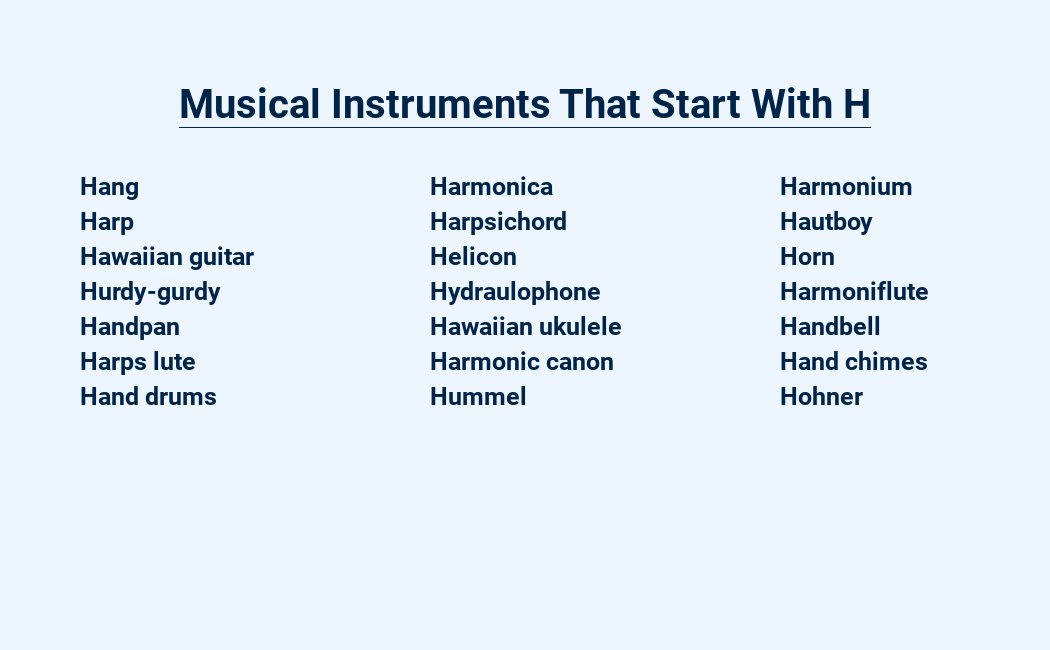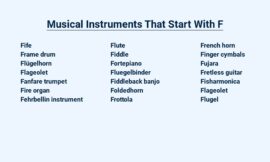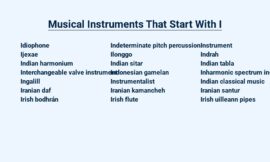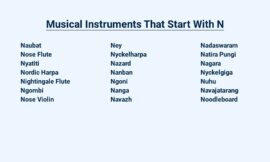Embark on a musical journey as we delve into the world of instruments beginning with “H.” Encounter the rich history, captivating sounds, and intriguing techniques behind the harmonica, harpsichord, Hawaiian guitar, and hurdy-gurdy.
Discover famous players and explore the unique characteristics that make each instrument captivating.
| Musical Instrument | Description |
| Harmonium | A keyboard instrument that produces sound by vibrating reeds. |
| Harp | A stringed instrument played by plucking the strings with the fingers. |
| Horn | A brass instrument played by blowing air through a mouthpiece. |
| Harmonica | A free-reed instrument played by blowing air through a mouthpiece. |
| Hurdy-gurdy | A stringed instrument played by turning a crank. |
Musical Instruments that Start with H
Harmonica
Harmonica, a pocket-sized instrument, captivates with its soulful melodies.
With a rich history rooted in blues and folk music, it enthralls listeners with its expressive range, from mellow whispers to vibrant wails.
History of the Harmonica
The harmonica’s origins can be traced back to ancient China, where it was known as the sheng. It was introduced to Europe in the 19th century and quickly gained popularity.
The harmonica was particularly popular among blues musicians in the early 20th century and has since become a staple of many genres of music.
Types of Harmonicas
Diatonic harmonicas are the most common type, with 10 holes and 20 notes. Chromatic harmonicas have a button that allows for half-steps, making them more versatile.
Tremolo harmonicas have two reeds per hole, creating a warbling sound.
Bass, octave, and chord harmonicas are also available, each with unique tonal qualities.
How to Play the Harmonica
To play the harmonica, hold it horizontally with your left hand cupping the bottom and your right hand covering the top. Blow or suck air through the mouthpiece to produce sound.
Experiment with different embouchures and techniques such as bending notes, vibrato, and tremolo to create unique sounds.
Practice regularly to improve your skills and master the harmonica.
Famous Harmonica Players
Sonny Boy Williamson, Little Walter, and Kim Wilson are some of the most celebrated harmonica players, thrilling audiences with their soulful melodies and dazzling techniques.
Harpsichord
History of the Harpsichord
The harpsichord emerged in the 16th century as an evolution of earlier keyboard instruments like the clavichord.
Its popularity peaked during the Baroque period, captivating audiences with its bright, distinct tone.
It remained a favorite choice for continuo accompaniment and solo performances until the rise of the piano.
Parts of a Harpsichord
- Soundboard: Amplifies the vibrations of the strings.
- Strings: Made of brass or iron, produce sound when plucked.
- Jacks: Small wooden pieces that pluck the strings.
- Action: The mechanism that connects the keys to the jacks.
- Case: The decorative wooden enclosure of the instrument.
How to Play the Harpsichord
To play the harpsichord, begin by understanding its layout and the different manuals. Practice playing basic chords and scales to familiarize yourself with the instrument.
Learn proper finger technique and hand position for efficient playing.
Study various musical pieces written specifically for the harpsichord to enhance your repertoire. Seek guidance from a qualified instructor or online resources for personalized instruction.
Famous Harpsichord Players
Renowned harpsichord virtuosos have captivated audiences with their exceptional talent and mastery of the instrument.
From the Baroque era to contemporary times, figures like Johann Sebastian Bach, George Frideric Handel, and Wanda Landowska have left an indelible mark on the musical world, showcasing the harpsichord’s versatility and expressive range.
Hawaiian Guitar
History of the Hawaiian Guitar
The Hawaiian guitar, also known as the slack-key guitar, originated in the 19th century. It is believed to have evolved from the Portuguese machete and Spanish guitar brought to Hawaii by immigrants.
The instrument gained popularity in the early 20th century and became a symbol of Hawaiian music.
Parts of a Hawaiian Guitar
- Body: Typically crafted from a hollow gourd or wood, giving it a unique rounded shape.
- Neck: Constructed from wood, with frets running along its length to mark different pitches.
- Strings: Traditionally made from gut or nylon, tuned to different notes for playing various melodies and harmonies.
- Tuning Pegs: Located at the headstock, used for adjusting the pitch of each string.
- Saddle: A small piece at the bridge where the strings rest, affecting intonation and sound quality.
How to Play the Hawaiian Guitar
- Position the guitar horizontally and place a steel bar across the strings.
- Select a tuning that suits your playing style.
- Use a slide to press down on the strings and create different notes.
- Strum or pluck the strings to produce sound.
- Experiment with different techniques to create unique melodies and harmonies.
Famous Hawaiian Guitar Players
- Gabby Pahinui: Renowned for his mastery of the slack-key guitar style, Pahinui’s soulful melodies captivated audiences.
- Cyril Pahinui: Brother of Gabby, Cyril’s innovative techniques and compositions earned him a place among Hawaiian guitar legends.
- Eddie Kamae: A versatile musician, Kamae’s skills on the ukulele, slack-key guitar, and steel guitar made him a sought-after session player.
Hurdy-Gurdy
History of the Hurdy-Gurdy
The hurdy-gurdy’s origins can be traced back to the medieval period. It is believed to have evolved from the organistrum, a larger instrument played by two people.
The hurdy-gurdy’s popularity grew during the Renaissance and Baroque periods, and it was often used in folk and religious music.
Parts of a Hurdy-Gurdy
- Pegbox: holds tuning pegs for strings.
- Neck: connects pegbox to body, supports strings.
- Fingerboard: player presses fingers here to change pitch.
- Body: main part of instrument, contains soundbox.
- Soundbox: amplifies sound of strings.
- Wheel: turned by crank, causes strings to vibrate.
- Crank: handle turned by player to rotate wheel.
How to Play the Hurdy-Gurdy
- Hold the hurdy-gurdy against your shoulder, resting the pegbox on your left shoulder.
- Use your right hand to crank the handle, which turns the wheel and rosined strings.
- Press the keys with your left hand to change the pitch of the melody strings.
- Use your right hand to play the drone strings, which provide a continuous, steady sound.
- Experiment with different techniques, such as vibrato and harmonics, to create a unique sound.
Famous Hurdy-Gurdy Players
Throughout history, several skilled musicians have left their mark on the world of hurdy-gurdy playing. From the renowned Baroque composer and virtuoso Marin Marais to the contemporary folk musician Valentin Clastrier, these talented individuals have captivated audiences with their exceptional performances and contributions to the rich tradition of hurdy-gurdy music.
Final Verdict
From the harmonica’s soulful melodies to the harpsichord’s elegant tunes, and the Hawaiian guitar’s enchanting sounds to the hurdy-gurdy’s medieval charm, musical instruments starting with ‘H’ offer a diverse and fascinating array of sounds and playing experiences.
These instruments have captivated audiences for centuries, leaving an indelible mark on the world of music.
Whether you’re a seasoned musician or just starting your musical journey, exploring these ‘H’ instruments can unlock new avenues of creativity and enjoyment.




